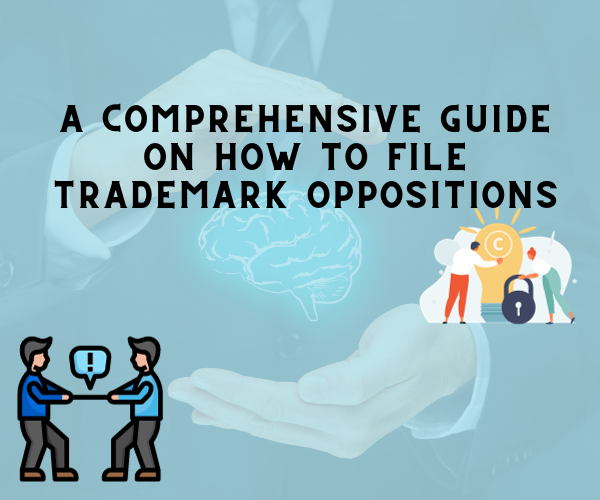For both individuals and businesses, trademarks stand as valuable assets, offering protection for unique brands, logos, and slogans. However, there are instances where an individual perceives that a trademark application by another person infringes upon their rights or interests. In such situations, the trademark opposition process becomes crucial, enabling applicants to effectively safeguard their intellectual property.
What is Trademark Opposition?
Trademark opposition is a legal process where individuals or businesses challenge a pending trademark application. Typically, this occurs after the trademark agency has examined and published the application for advertisement. Any entity spotting an identical or similar trademark in the Trademark Journal can file an opposition to its registration. The Trademark Act, 1999, and the Trade Marks Rules, 2017 (“Trade Mark Rules”) outline the trademark opposition process. Grounds for opposition include scenarios where the opposed trademark is identical or similar to an existing registered trademark, descriptive in nature, lacks distinctive character, or is likely to cause confusion or deceive the public, among others.
Contents of a Trademark Opposition
The opponent must file Form TM-O in order to oppose a trademark. The opposition to the trademark must be submitted to the relevant trademark authority in accordance with the application. The following information needs to be incorporated in the notice of opposition as stipulated under Rule 43 of the Trade Mark Rules-
Details about the trademark application – This includes the Impugned application number, Indication of the goods or services from the trademark application and the name of the applicant for the trademark sought to be opposed.
Details about the opposing party – If the opposition is filed by the trademark owner of an earlier mark, thenthe name and address of the prior trademark’s owner and an indication that he is the trademark owner of such trademark.If a trademark licensee files the opposition, then the name and address of the trademark licensee along with an indication that he or she has been authorized to enter the opposition. If a successor files the opposition to the registered trademark owner then the name and address of the successor and an indication of the date on which the application for registration of the new proprietor was received by the appropriate office or where this information is not available, was sent to the appropriate office. If a party outside India files the opposition, then the name and address the opposing party and Indian address for service The trademark opponent or an authorized person who is acquainted with the case’s facts should sign the notice of the opposition.
Details of the trademark application against which the opposition is entered – A list of the goods or services listed in the trade mark application against which opposition is entered, the name of the applicant for the trade mark, and the application number against which opposition is entered.
Details of earlier mark or the earlier right on which the opposition is based – If the opposition is founded on an already-filed trademark application or registered trademark, the application number or registration number of the earlier mark should be furnished. If the objection is based on a mark that is allegedly a well-known trade mark, it should specify the country or territory in which the earlier mark is recognized as being well-known.
Details of the opposing party – When submitting an opposition, the owner of an earlier mark or earlier right is required to include his name, address, and a declaration proving his ownership of the mark or right. Any opposition filed by the successor in title to the registered proprietor of a trade mark who has not yet been registered as the new proprietor should include the name, address, and dates of when the new proprietor’s application for registration was received by the relevant office. If the other party does not have a place of business in India, the name of the opponent and his address for service in India should be included.
Trademark Opposition Procedure
Notice of Trademark Opposition – Rule 42
Within four months of the trademark application’s advertisement in the trademark journal, one may submit a trademark opposition request to the Registrar by submitting a notice in Form TM-O and paying fees. A copy of the notice of opposition will be sent by the Registrar to the applicant, or the individual who filed the application for trademark registration.
Counterstatement by Applicant – Rule 44
The applicant has two months from the date of receipt of the Opposition notice, to use Form TM-O to submit a counterstatement with the facts and arguments contending the notice of opposition. Once filed, the Registrar will dispatch a copy of the counterstatement to the opposing party.
The Registrar will consider the trademark registration application abandoned and will not proceed with trademark registration if the applicant fails to file the counter statement within two months of receiving the notice of opposition.
Evidence in Support of Opposition – Rule 45
Within two months of receiving a copy of the applicant’s counterstatement, the Opponent is required to file evidence supporting its opposition. Accordingly, once filed, the Opponent has to forward copies of the evidence to the Applicant within the two month deadline. Alternatively, if the Opponent fails to file the evidence, the opposition will be deemed as abandoned.
Evidence in Support of Trade Mark Application – Rule 46
The Applicant thereafter, has two months to file evidence to support their trademark application and substantiate why the trademark should not be refused. This deadline too, begins from the date of receipt of the evidence in support of opposition by the Opponent. The Applicant should then proceed to forward copies of the evidence to the Opponent. However, if the Applicant fails to file evidence, the trademark application will be deemed as abandoned.
Evidence in Reply and Further Evidence – Rule 47 & 48
Once the Opponent receives the Evidence in support of the Application, the Opponent may submit more evidence as evidence in reply within one month from the date of receipt. However, this is not a mandatory stage, and if the Opponent does not submit any evidence in reply, then opposition will proceed to hearing. The Trade Mark Rules also stipulate that in proceedings before the Registrar, he may as per his discretion, allow either the applicant or the opponent to adduce additional evidence.
Hearing and Decision Concerning Trademark Opposition – Rule 50
Once the prosecution stage is concluded, both parties will receive notice of the first hearing date from the registrar following the receipt of the documents and evidence from both sides.
The registrar will take on record the written and oral submission of the parties, and accordingly pass an order. If the Opposition succeeds, then the mark will be refused, however if the Opposition fails, then the mark will proceed towards registration. Accordingly, the order of the Registrar will be provided to both the parties.
Conclusion of the Trademark Opposition
If the applicant is successfully contests the opposition, the trademark will be registered and the Registrar will issue a trademark registration certificate, upon payment of requite fee and an application under form TM M.
A vital measure in protecting intellectual property and upholding the distinctiveness of a brand involves trademark opposition where necessary. Despite the perceived complexity of the procedure, success in filing a trademark opposition and safeguarding invaluable trademarks is attainable when guided by proper legal counsel and a comprehensive understanding of the process. It is crucial to emphasize that the key to a triumphant opposition lies in timely action and effective legal representation.




